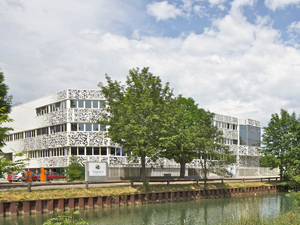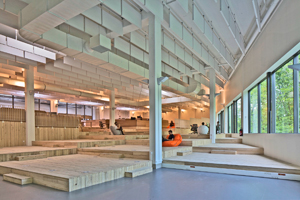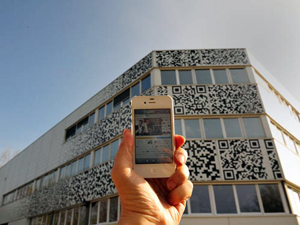 |
 |
 |
 |
 |
 |
| |
 |
|
 |
 |
 |
  |
  |
 |
 |
 |
 |
|
|
 |
|
 |
 |
 |
BUILDING |
 |
|
 |
|
 |
 |
 |
| |
 |
| 
 |
Teletech Campus
|
|
 |
 |
 |
 |
DESIGNER |
 |
|
|
 |
|
 |
 |
 |
| |
 |
|
 |
 |
 |
 |
DESCRIPTION |
 |
|
|
 |
|
 |
 |
 |
|
|
 |
 All over Europe buildings are vacant and waiting for a new future. Transformations are usually all about the preservation of historically or architecturally significant parts of a building. In this case the building was completed in 2004 and the preservation act directed towards reuse. The building is a former Unilever Amora Dijon mustard laboratory completed in 2004 and closed only five years later in 2009. The building was in a good state but due to its wide volume not suitable for traditional work spaces. The construction budget was too low to exchange the façade or make serious alterations to the structure. The budget makes literal reuse necessary and leads to less replacements and a better sustainable profile of the transformation act. A fine balance between intervention and intelligent re-use of the existing is the essence of the project. MVRDV sees this transformation as an exemplary project for contemporary European architecture in times of the current crisis. How to reuse a building which is structurally in good shape but not suitable for a traditional transformation and use? The more reuse of the existing is possible the more budget is liberated for interventions. The unusual building evokes an unusual use and in the end will adjust perfectly to the Teletech work rhythm. All over Europe buildings are vacant and waiting for a new future. Transformations are usually all about the preservation of historically or architecturally significant parts of a building. In this case the building was completed in 2004 and the preservation act directed towards reuse. The building is a former Unilever Amora Dijon mustard laboratory completed in 2004 and closed only five years later in 2009. The building was in a good state but due to its wide volume not suitable for traditional work spaces. The construction budget was too low to exchange the façade or make serious alterations to the structure. The budget makes literal reuse necessary and leads to less replacements and a better sustainable profile of the transformation act. A fine balance between intervention and intelligent re-use of the existing is the essence of the project. MVRDV sees this transformation as an exemplary project for contemporary European architecture in times of the current crisis. How to reuse a building which is structurally in good shape but not suitable for a traditional transformation and use? The more reuse of the existing is possible the more budget is liberated for interventions. The unusual building evokes an unusual use and in the end will adjust perfectly to the Teletech work rhythm.
 The Teletech call centre has rush hours in the morning, afternoon and early evening, only at these moments the building will be fully occupied by its workforce. For these short periods also unusual work places can be used which would not be suitable for eight hour shifts. The transformation strategy is adapted to this irregular use of the building. The inside is turned into a work landscape and the 600 young call centre operators will have flexible spaces: they can log in anywhere they want inside this work landscape. Different qualities such as silent, open or secluded places are offered. The way young people often work, with a laptop on the sofa or bed, was an inspiration for the interior design: the space needs to appeal to the operators to work the way they like, the space will be informally furnished with homely objects to provide a fun and creative working environment. The Teletech call centre has rush hours in the morning, afternoon and early evening, only at these moments the building will be fully occupied by its workforce. For these short periods also unusual work places can be used which would not be suitable for eight hour shifts. The transformation strategy is adapted to this irregular use of the building. The inside is turned into a work landscape and the 600 young call centre operators will have flexible spaces: they can log in anywhere they want inside this work landscape. Different qualities such as silent, open or secluded places are offered. The way young people often work, with a laptop on the sofa or bed, was an inspiration for the interior design: the space needs to appeal to the operators to work the way they like, the space will be informally furnished with homely objects to provide a fun and creative working environment.
Outside the rush hours the call centre operators will have free time in which they can make use of the education centre, fitness centre, a gallery and projects incubator, also located inside the building. A big window, entresol spaces, skylights and a large atrium are used to create a community feeling and allow for daylight penetrating the 40 x 70 metres volume. As these interventions use up a large part of the budget other parts had to be designed as economically as possible. The façade for example could not be exchanged but is transformed with a simple print of a QR flashcode translated into the activities of the company; the façade acts as communicator and signals the transformation. The ground floor contains parking and cannot be inhabited as the building is located on a flood plain. In many cases the budget only allowed to remove or paint the existing elements. The result however is an exciting work space and radically contradicts the usual call centre which is often a series of tedious cubicles. |
|
 |
 |
 |
|
 |
|
|
|
 |
 Teletech is a French service provider with call centres all over the world. In Dijon, Teletech International will experiment with this combination of call centre, education centre, leisure space and incubator to create and maintain jobs in France which are generally outsourced to developing countries. Despite the worldwide trend in this sector to reduce costs and constantly increase Taylorism, the company invests massively in its social policy along with this construction project. The ambition is directed towards reinventing and revolutionising existing procedures to improve customer brand relationships through a better qualified call centre agent. Teletech International believes that a qualitative work space is a part of the solution in creating a higher level of interaction with the consumers. The company will attract, teach and keep high level profile employees on site which can offer specialised and sophisticated services. The new building and the social program are an essential part of this innovative strategy. Teletech is a French service provider with call centres all over the world. In Dijon, Teletech International will experiment with this combination of call centre, education centre, leisure space and incubator to create and maintain jobs in France which are generally outsourced to developing countries. Despite the worldwide trend in this sector to reduce costs and constantly increase Taylorism, the company invests massively in its social policy along with this construction project. The ambition is directed towards reinventing and revolutionising existing procedures to improve customer brand relationships through a better qualified call centre agent. Teletech International believes that a qualitative work space is a part of the solution in creating a higher level of interaction with the consumers. The company will attract, teach and keep high level profile employees on site which can offer specialised and sophisticated services. The new building and the social program are an essential part of this innovative strategy. |
|
 |
 |
 |
 |
 |
 |
 |
LOCATION |
 |
|
|
 |
|
 |
 |
 |

|
 |

|
Continent |
|
 |
|
Nation |
|
 |
|
Region |
|
 |
|
District |
|
 |
|
Town |
|
 |
|
Address |
|
 |
|
|
|
 |
|
Website |
|
 |
|
 |
 |
 |
 |
MAP |
 |
|
|
 |
|
 |
 |
 |
| |
 |
|
 |
 |
 |
 |
|
TYPOLOGY |
 |
|
|
 |
|
 |
 |
 |
|
|
 |
ARCHITECTURE | Education buildings
Training centres and schools
Research buildings and centers
Scientific and technological park
Buildings for offices and professional practises
Data processing center, call center
| |
 |
 |
 |
 |
CHRONOLOGY |
 |
|
|
 |
|
 |
 |
 |
Realisation |
 |
|
 |
| 
 |
2012 |
|
 |
 |
 |
 |
CLIENT |
 |
|
|
 |
|
 |
 |
 |
| |
 |
|
 |
 |
 |
 |
CREDITS |
 |
|
|
 |
|
 |
 |
 |
| |
 |
Photos © Philippe Ruault, MVRDV
Text edited by MVRDV
Courtesy by MVRDV
|
|
 |
  |
 |
|
|